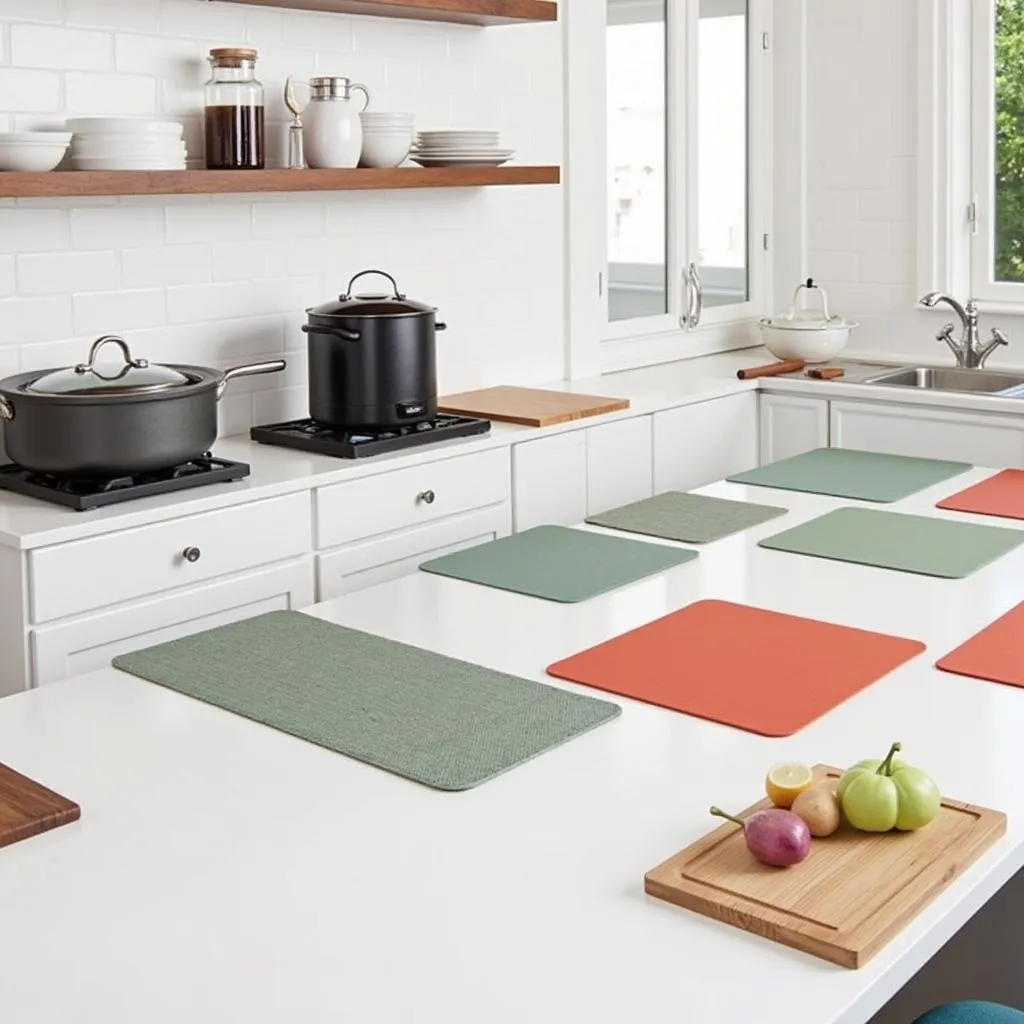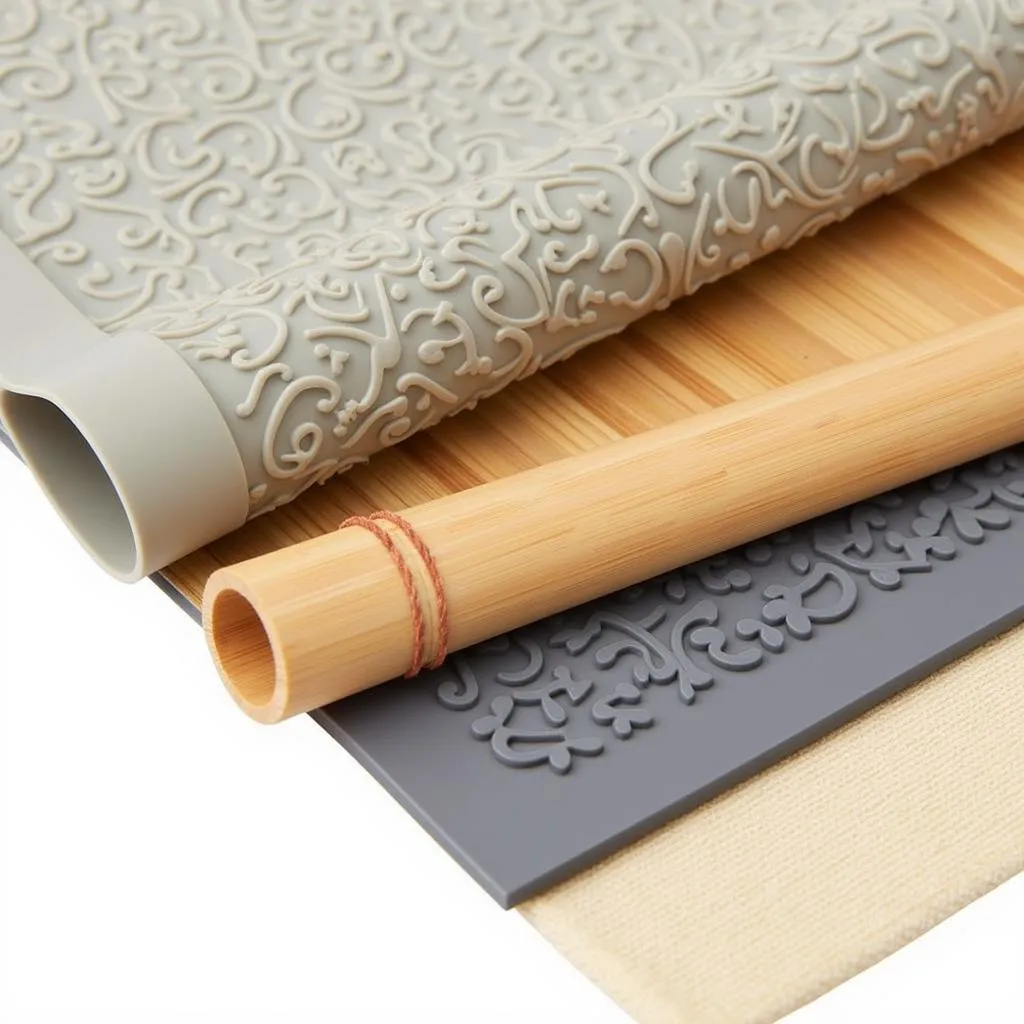Food Mats are an essential kitchen accessory that often gets overlooked. They provide a protective barrier between your countertops and spills, crumbs, and hot dishes. But beyond their practical uses, food mats can also add a touch of style and personality to your kitchen décor. Whether you’re a seasoned chef or a casual cook, this comprehensive guide will explore everything you need to know about food mats, from choosing the right materials to styling tips and maintenance advice.
Why You Need Food Mats in Your Kitchen
Imagine this: you’re in the middle of preparing a delicious meal, chopping vegetables, whisking sauces, and things are getting a little messy. This is where food mats step in as your trusty sidekick. They act like a shield for your precious countertops, preventing unsightly stains from spills and scratches from sharp utensils.
But the benefits go beyond protection. Food mats also:
- Enhance your kitchen’s aesthetic: With a wide array of colors, patterns, and materials available, food mats can complement your kitchen’s theme and add a touch of your personal style.
- Provide a hygienic surface: Easy to clean and sanitize, food mats help maintain a hygienic cooking environment by preventing the build-up of bacteria and germs.
- Protect delicate glassware: Placing a food mat under your dish drying rack provides a cushioned surface that prevents glassware from chipping or breaking.
- Offer convenience: Use food mats as trivets for hot pots and pans, protecting your tabletops and countertops from heat damage.
 Kitchen counter with various food mats
Kitchen counter with various food mats
Choosing the Right Food Mat: Materials and Considerations
The ideal food mat for your kitchen depends on your specific needs and preferences. Here’s a breakdown of the most popular materials:
1. Silicone Food Mats
Pros:
- Highly durable and heat-resistant
- Non-slip surface
- Easy to clean and dishwasher safe
- Available in a wide range of colors and designs
Cons:
- Can be prone to staining
- May absorb strong odors
Best for: Everyday use, protecting countertops from hot dishes and spills, kneading dough.
2. Rubber Food Mats
Pros:
- Excellent grip and non-slip properties
- Durable and long-lasting
- Water-resistant and easy to clean
- Affordable
Cons:
- May have a distinct rubber odor
- Limited design options compared to other materials
Best for: Underneath appliances, pet food and water bowls, providing a non-slip surface in high-traffic areas.
 Close up of different food mat materials
Close up of different food mat materials
3. Bamboo Food Mats
Pros:
- Eco-friendly and sustainable material
- Naturally antimicrobial
- Stylish and modern aesthetic
Cons:
- Not as heat-resistant as silicone or rubber
- Requires hand washing to maintain its quality
Best for: Adding a touch of natural elegance to your kitchen, serving food, using as trivets for warm dishes.
4. Microfiber Food Mats
Pros:
- Highly absorbent
- Quick-drying
- Machine washable for easy cleaning
Cons:
- Not heat-resistant
- Can be less durable than other materials
Best for: Drying dishes, absorbing spills, lining shelves and drawers.
Expert Insights: Choosing the Perfect Food Mat
“When choosing a food mat, consider your lifestyle and the specific needs of your kitchen,” says renowned chef and kitchenware designer, Emily Carter. “If you frequently cook with hot pans, prioritize heat resistance. For busy families with kids, opt for durable and easy-to-clean materials.”
Maintaining Your Food Mats: Tips for Long-lasting Use
To keep your food mats looking their best and ensure their longevity, follow these care tips:
- Clean your food mats regularly: Wash with warm soapy water after each use, or follow the manufacturer’s cleaning instructions.
- Avoid harsh chemicals: Harsh cleaning agents can damage the material and reduce the lifespan of your food mats.
- Air dry thoroughly: Allow your mats to air dry completely before storing them to prevent mildew and unpleasant odors.
- Store properly: Store your food mats in a clean and dry place, rolled up or laid flat, depending on the material.
Conclusion: Elevate Your Kitchen with the Power of Food Mats
Food mats are an indispensable kitchen tool, offering both practicality and style. From protecting your surfaces to adding a decorative touch, the right food mat can enhance your culinary experience while keeping your kitchen clean and organized. Consider your needs, explore the diverse range of materials available, and invest in high-quality food mats that will serve you well for years to come.
FAQs: Frequently Asked Questions about Food Mats
1. Can I use food mats in the microwave?
While some silicone food mats are microwave-safe, it’s essential to check the manufacturer’s instructions before doing so. Other materials, such as rubber and bamboo, are not microwave-safe.
2. How often should I replace my food mats?
The lifespan of a food mat depends on the material and frequency of use. As a general rule, replace your mats when they show signs of wear and tear, such as cracks, discoloration, or persistent odors.
3. Can food mats be used outdoors?
Yes, some food mats, particularly those made from durable materials like silicone or rubber, can be used outdoors on patios, decks, or picnic tables.
4. Are food mats BPA-free?
Many food mats on the market are made from BPA-free materials. Look for labels or product descriptions that specifically state “BPA-free” to ensure your safety.
5. Can I cut my food mats to size?
It’s not recommended to cut food mats as it may compromise their integrity and functionality. It’s best to choose mats that fit your needs or opt for custom-sized options if available.
Need More Help?
For further assistance in choosing the perfect food safe crinkle paper or any other kitchen essentials, our dedicated customer support team is always ready to help. Contact us at Phone Number: 02437655121, Email: minacones@gmail.com Or visit our store: 3PGH+8R9, ĐT70A, thôn Trung, Bắc Từ Liêm, Hà Nội, Việt Nam. We offer 24/7 customer service to ensure your satisfaction.